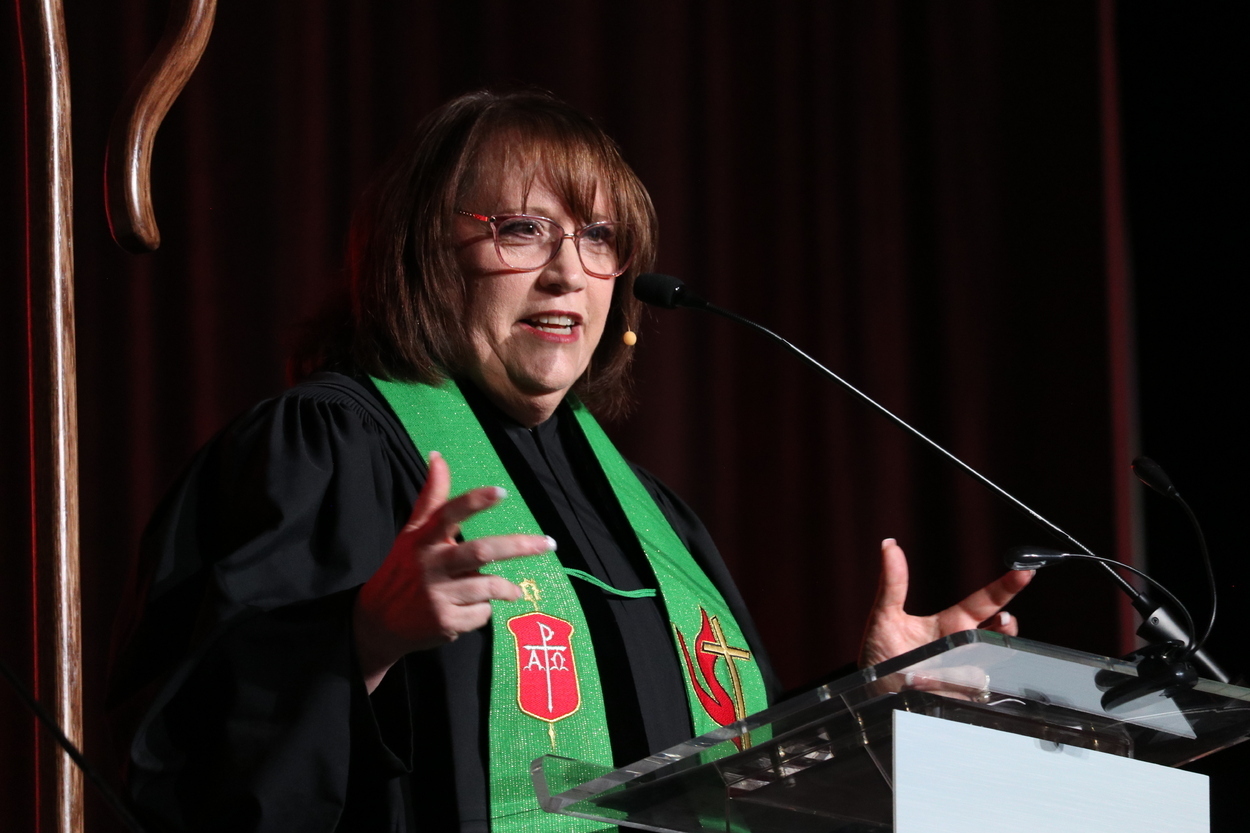
Opening worship with Bishop Lanette Plambeck: “I have a confession”

Bishop Lanette Plambeck delivers the message at opening worship at the 2024 North Central Jurisdictional Conference in Sioux Falls, South Dakota. Photo by NCJ communicators.
“I have a confession to make,” Bishop Lanette Plambeck told hundreds gathered at the North Central Jurisdictional Conference in Sioux Falls, South Dakota. “I’ve discovered in my assignment in the Dakotas-Minnesota Episcopal Area that I’m an edge walker.”
At opening worship on Wednesday afternoon, she explained that edge walkers are called to live and lead where two cultures meet.
Bishop Lanette shared the story of going to dinner in Rapid City, South Dakota, with two of her district superintendents last winter. She noticed on a nearby street corner was a group of American Indian siblings, some of whom were intoxicated—and a deep sense of both culpability and compassion simultaneously rose up in her. “Our Anglo ancestors brought in a substance that has decimated a community, and it was a crisis moment for me,” she said.
A short time later, three police cars showed up and officers began loading the men into their vehicles to take them to the local jail for the evening. Earlier that day, one of their Native siblings had frozen to death, and the officers recognized that if they arrested the men for the evening, they would be protected from the elements, and have a place to sleep and a meal to eat. “There is much confession in the midst of that,” Bishop Lanette noted.
She held out a braid of sweetgrass and explained that sweetgrass grows in a place called an “ecotone.” Ecotones are where two diverse ecological communities come together in rich, vibrant ways and new life grows. This can happen when a forest meets a field or when a waterway meets land, for example.
Jesus, “the edge walker of all edge walkers,” knows the importance of ecotones, Bishop Lanette told those gathered. He went to places where others wouldn’t go, saw people others wouldn’t see, and did something others couldn’t do: He created an ecotone that came to be known as the church—a church that was told, “You can’t just stay in Jerusalem. You have to go to Judea and Samaria and to the edges of the earth because you, church, are edge-walking people.”
“Aren’t we all edge walkers, called to be in that space called church?” Bishop Lanette asked delegates and visitors seated in the Sioux Falls Convention Center. “It is important to claim who we are as the edge-walking people because there are two things that can happen for the church: Either we become an ecotone or we become an echo chamber.”
Bishop Lanette said that Native pastors in Minnesota have been teaching her what it means to be a good relative, to admit hard truths, and to confess real sin. In fact, one taught her that the braiding of sweetgrass should never be done alone; you get a better braid when you have two people working together.
The Dakotas-Minnesota Area is beginning to dream and scheme about how to partner with Native people, Bishop Lanette shared. The Minnesota Conference is planting two new Native ministries this year, and the Dakotas Conference is committing to walk alongside trafficked women and children.
“I have a confession to make,” Bishop Lanette said. “I know that North Dakota, South Dakota, and Minnesota are not the only lands with Native siblings residing. I know that this episcopal area is not the only area dreaming of new ways of being better siblings to those who were here first…We collectively have the opportunity to do a good thing.”
We have an opportunity to be Jesus to others, she explained—people of joy and justice; people grounded in the teachings of John, Charles, and Susanna Wesley; people who sit alongside others, holding one end of the sweetgrass as they hold the other, braiding together relationships marked by grace, humility, and love.
Right at the start of the North Central Jurisdictional Conference, before worship even began, Bishop Lanette highlighted the American Indian tribes that call the Dakotas home—and named some of the ways in which they have been harmed. “We acknowledge that our churches have been built on the homelands of our Native siblings and their ancestors,” she said. “We took land and we gave boarding schools, smallpox, disease, alcohol. It is up to us to work to repair the damages of settler colonialism by sharing accurate histories, building and sustaining meaningful relationships with our Native neighbors, and working toward authentic acts of healing in the building of genuine relationships. North Central Jurisdictional Conference, we invite you to join with us in these efforts.”
She ended her message during worship with one final confession: “There’s so much for me to yet learn.” Alongside that confession, she made a commitment: “When we say to lift every voice, that we will do it, that we will lean into the story, that we will lean into learning, that we will lean into love.”
“There is something about the goodness of God that the world is crying out for,” she said. “Let us not get caught in our own echo chamber, but let us take the culture, if you will, of the people called United Methodist and be intentional about getting alongside of other cultures…so that ecosystems, ecotones, can develop. We call that Beloved Community.”
View a video of the message